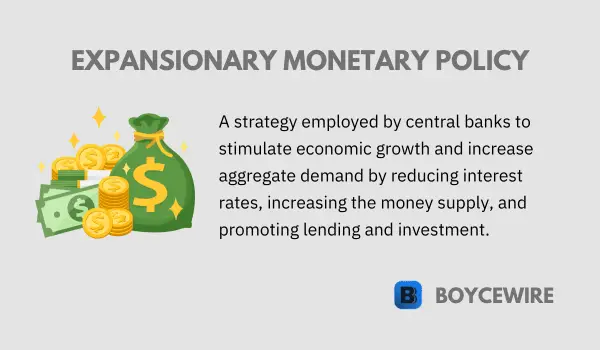Expansionary Monetary Policy: Definition, Tools & Examples

What is Expansionary Monetary Policy?
The expansionary monetary policy is an essential tool used by central banks to stimulate economic growth and combat recessions. This type of policy is enacted when an economy is facing a slowdown or a contraction, and it involves measures aimed at increasing the money supply and lowering borrowing costs.
The primary objective of an expansionary monetary policy is to boost aggregate demand, which in turn encourages investment, job creation, and consumer spending. This article will provide an overview of the tools used to implement expansionary monetary policy, the role of central banks, the effects of such policy on the economy, and its limitations and challenges. By examining real-world examples, we will gain insights into the importance of expansionary monetary policy and its role in managing economic fluctuations.
Key Points
- Expansionary monetary policy is a strategy implemented by central banks to stimulate economic growth and increase aggregate demand.
- The main goal of expansionary monetary policy is to encourage borrowing and spending, leading to increased investment, consumption, and economic activity.
- Central banks employ various tools, such as reducing interest rates, buying government securities, and lowering reserve requirements, to increase the money supply and lower borrowing costs.
Tools of Expansionary Monetary Policy
Central banks employ various tools to implement expansionary monetary policy. These tools are designed to increase the money supply, lower interest rates, and make credit more accessible, ultimately promoting economic growth. Some of the key tools of expansionary monetary policy include:
- Open Market Operations (OMO) Open market operations involve the purchase and sale of government securities, such as treasury bonds, by the central bank in the open market. When implementing an expansionary policy, the central bank purchases these securities, injecting liquidity into the banking system and increasing the money supply. This action also drives down interest rates, making borrowing more affordable.
- Lowering the Reserve Requirement Ratio The reserve requirement ratio is the percentage of deposits that commercial banks are required to hold as reserves, either as cash or as deposits with the central bank. By lowering this ratio, the central bank allows banks to lend out a larger portion of their deposits, which increases the money supply and stimulates borrowing and investment.
- Lowering the Discount Rate The discount rate is the interest rate at which commercial banks can borrow funds from the central bank. When the central bank lowers the discount rate, it becomes less expensive for banks to borrow, which encourages them to lend more money to businesses and consumers. This increased lending further expands the money supply and lowers interest rates.
- Quantitative Easing (QE) Quantitative easing is an unconventional monetary policy tool used by central banks during periods of severe economic downturns or when traditional tools become less effective. Under QE, the central bank purchases large amounts of financial assets, such as government bonds and mortgage-backed securities, from banks and other financial institutions. This action increases the money supply, lowers long-term interest rates, and stimulates lending and investment.
These tools are used in combination to achieve the desired expansionary effect on the economy. By employing these methods, central banks aim to boost economic activity, promote job creation, and avoid or mitigate the negative impacts of economic slowdowns.
Role of Central Bank in Expansionary Monetary Policy
The central bank plays a critical role in implementing expansionary monetary policy and managing a nation’s money supply. Its primary objective is to ensure price stability and promote sustainable economic growth. In times of economic downturn or slow growth, the central bank may use expansionary monetary policy to stimulate economic activity and prevent deflation. The role of the central bank in expansionary monetary policy includes the following key functions:
1. Setting Interest Rates
Central banks establish the target interest rates that influence borrowing costs for businesses and consumers. By lowering the target interest rate, the central bank encourages borrowing, spending, and investment, which in turn stimulates economic growth.
2. Supervising the Banking System
Central banks are responsible for supervising and regulating commercial banks to ensure they maintain a safe and stable financial environment. This supervision includes setting reserve requirement ratios, conducting stress tests, and monitoring banks’ lending practices to prevent excessive risk-taking and ensure the effectiveness of monetary policy measures.
3. Managing Inflation Expectations
Central banks are tasked with managing public expectations about future inflation rates. By implementing expansionary monetary policy and communicating its intentions clearly, the central bank can influence expectations and promote confidence in the economy. This confidence can lead to increased spending and investment, which further supports economic growth.
4. Acting as Lender of Last Resort
During times of financial crisis or severe economic downturns, the central bank may act as the lender of last resort, providing emergency liquidity to financial institutions to maintain stability in the banking system. This role is crucial for preventing a complete collapse of the financial system and ensuring the continued flow of credit to businesses and consumers.
By performing these functions, the central bank plays a crucial role in managing the economy and ensuring that expansionary monetary policy measures are effectively implemented. Through its actions, the central bank can help create an environment conducive to economic growth and stability.
Effects of Expansionary Monetary Policy
Expansionary monetary policy aims to stimulate economic growth by increasing the money supply and lowering borrowing costs. It can have various short-term and long-term effects on the economy, including:
- Increased Aggregate Demand: Lower interest rates encourage consumers and businesses to borrow and spend more, leading to an increase in aggregate demand for goods and services. This higher demand can stimulate economic growth and boost employment levels.
- Higher Inflation: As expansionary monetary policy increases the money supply, it can lead to a rise in inflation. When done in moderation, this can be beneficial, as it helps to prevent deflation and encourages spending. However, if inflation rises too quickly, it may erode purchasing power and create uncertainty in the economy.
- Currency Depreciation: A more accommodative monetary policy may lead to a depreciation of the domestic currency, as lower interest rates make it less attractive to foreign investors. This can result in increased exports, as goods and services become cheaper for foreign buyers, but may also lead to higher import costs, which can contribute to inflation.
- Asset Price Inflation: By lowering borrowing costs, expansionary monetary policy can contribute to a rise in asset prices, such as stocks and real estate. This can create wealth effects, encouraging further spending and investment. However, it can also lead to asset bubbles if prices become detached from their fundamental values.
- Interest Rate Risk: Persistent low-interest rates can lead to a buildup of risks in the financial system, as investors search for higher yields by taking on riskier investments. This may contribute to financial instability and increase the likelihood of a financial crisis.
- Long-term Growth Implications: While expansionary monetary policy can provide short-term stimulus to the economy, it may not necessarily lead to sustainable long-term growth. Overreliance on monetary policy measures can result in an unbalanced policy mix, where fiscal and structural reforms are neglected. This can limit the long-term growth potential of the economy.
Advantages of Expansionary Monetary Policy
1. Stimulates Economic Growth
Expansionary monetary policy can help boost economic growth by increasing aggregate demand and encouraging businesses to invest and hire more workers. This can be particularly helpful during periods of economic stagnation or recession, as it can help kickstart the economy and prevent prolonged downturns.
2. Reduces Unemployment
By stimulating economic activity, expansionary monetary policy can help create new job opportunities and reduce unemployment levels. Lower interest rates can make it more affordable for businesses to finance new projects and expand their operations, leading to increased demand for labor.
3. Prevents Deflation
Expansionary monetary policy can help prevent deflation, which occurs when prices fall over time. Deflation can be harmful to an economy, as it can lead to reduced consumer spending and increased debt burdens. By increasing the money supply and promoting moderate inflation, expansionary policy can help avoid these negative consequences.
4.Lowers Borrowing Costs
Lower interest rates make it cheaper for consumers and businesses to borrow money, which can encourage spending and investment. This can lead to increased economic activity and higher levels of growth.
5. Supports Financial Stability
In times of financial stress or crisis, expansionary monetary policy can help restore confidence in the financial system by providing liquidity and ensuring that credit continues to flow through the economy. This can help prevent the collapse of financial institutions and mitigate the impact of financial crises on the broader economy.
6. Improves International Competitiveness
A side effect of expansionary monetary policy can be the depreciation of the domestic currency, making exports more competitive in global markets. This can boost export-driven industries, stimulate economic growth, and improve the balance of trade.
While there are several advantages to using expansionary monetary policy, it is important for policymakers to balance these benefits with the potential risks and drawbacks, such as higher inflation and financial instability. Careful management and coordination with fiscal and structural policies can help maximize the benefits of expansionary policy while minimizing potential negative consequences.
Disadvantages of Expansionary Monetary Policy
1. Inflation Risk
One of the main disadvantages of expansionary monetary policy is the risk of inflation. When the money supply increases, it can lead to higher demand for goods and services, which in turn can push up prices. If not managed carefully, this can result in high inflation, eroding the purchasing power of money and creating economic instability.
2. Asset Bubbles
Lower interest rates can encourage excessive borrowing and risk-taking, leading to the creation of asset bubbles in markets such as real estate and stocks. These bubbles can eventually burst, causing significant economic disruption and financial losses for investors.
3. Currency Depreciation
Expansionary monetary policy can cause the domestic currency to depreciate, which can have negative consequences for import-dependent industries and consumers. Higher import prices can lead to increased inflation and reduced purchasing power for consumers.
4. Distributional Effects
Lower interest rates can disproportionately benefit borrowers at the expense of savers, as the returns on savings are reduced. This can create wealth disparities and exacerbate income inequality in the economy.
5. Short-term Focus
Expansionary monetary policy can encourage short-term thinking by businesses and consumers, as lower borrowing costs may lead to an overemphasis on immediate gains rather than long-term sustainability. This can result in misallocation of resources and hinder long-term economic growth.
6. Limitations in Effectiveness
In some situations, expansionary monetary policy may be less effective in stimulating economic activity. For example, during a liquidity trap, where interest rates are already near zero, further reductions may have little impact on borrowing and spending. Additionally, if consumers and businesses are pessimistic about future economic prospects, they may be reluctant to borrow and invest, even if interest rates are low.
Examples
United States – Post 2008 Financial Crisis
In response to the global financial crisis, the U.S. Federal Reserve implemented a series of expansionary monetary policies, including lowering the federal funds rate to near zero and initiating quantitative easing (QE) programs. These measures aimed to stabilize the financial system, stimulate lending, and promote economic growth. The U.S. economy eventually recovered, but debates continue over the long-term effects of these policies.
European Central Bank – Response to Eurozone Crisis
The European Central Bank (ECB) pursued expansionary monetary policy to address the Eurozone debt crisis and stimulate economic growth. The ECB lowered interest rates and launched asset purchase programs to inject liquidity into the financial system. Although these measures helped stabilize the Eurozone, they also led to concerns about long-term inflation and the sustainability of sovereign debt.
Japan – Fight Against Deflation
Japan has experienced prolonged periods of deflation and economic stagnation since the 1990s. The Bank of Japan (BOJ) has implemented multiple rounds of expansionary monetary policy, including near-zero interest rates and quantitative easing, to combat deflation and stimulate growth. Despite these efforts, Japan’s economy has struggled to achieve consistent growth and inflation targets.
China – Stimulus During Global Economic Slowdown
In response to the global economic slowdown in 2008 and 2015, the People’s Bank of China (PBOC) implemented expansionary monetary policies, including lowering interest rates and reserve requirements. These measures aimed to maintain economic growth and stability in China, but also raised concerns about rising debt levels and potential asset bubbles.
Conclusion
In conclusion, expansionary monetary policy plays a crucial role in stimulating economic growth, addressing recessions, and maintaining financial stability. Through various tools such as lowering interest rates, increasing the money supply, and implementing asset purchase programs, central banks can influence lending, spending, and investment to counter economic downturns. However, the effectiveness of expansionary monetary policy depends on the specific economic context and the timely execution of these measures.
While expansionary monetary policy has its advantages, such as boosting demand, promoting job creation, and fostering economic growth, it also comes with potential drawbacks. These include the risk of high inflation, asset bubbles, and increased debt levels, which can create long-term challenges for an economy. Real-world examples of expansionary monetary policy, such as those implemented in the United States, Eurozone, Japan, and China, demonstrate its impact on diverse economic situations and the need for a balanced approach in assessing its benefits and limitations. Central banks must carefully consider these factors when designing and implementing expansionary monetary policies to achieve desired economic outcomes.
FAQs
Expansionary monetary policy refers to the actions taken by central banks to stimulate economic growth and increase aggregate demand by loosening monetary conditions.
Central banks use several tools, including lowering interest rates, conducting open market operations (buying government securities), and reducing reserve requirements for banks.
Lowering interest rates encourages borrowing and investment, as it reduces the cost of borrowing and incentivizes businesses and individuals to take on loans for productive activities.
Expansionary monetary policy aims to increase borrowing, consumption, investment, and overall economic activity. It can stimulate job creation, reduce unemployment, and promote economic growth.
About Paul
Paul Boyce is an economics editor with over 10 years experience in the industry. Currently working as a consultant within the financial services sector, Paul is the CEO and chief editor of BoyceWire. He has written publications for FEE, the Mises Institute, and many others.

Further Reading
 Importance of Entrepreneurship - Entrepreneurship is the act by an individual to start and develop their own business.
Importance of Entrepreneurship - Entrepreneurship is the act by an individual to start and develop their own business.  Factors of Production: Definition, 4 Factors & Examples - The factors of production are all the various elements that are required to come together to create a good.
Factors of Production: Definition, 4 Factors & Examples - The factors of production are all the various elements that are required to come together to create a good.  Present Value: Definition, Criticisms & Example - Present value (PV) is the current value of a future sum of money, or stream of revenue. Tihs is calculated…
Present Value: Definition, Criticisms & Example - Present value (PV) is the current value of a future sum of money, or stream of revenue. Tihs is calculated… 